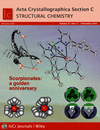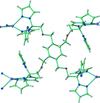issue contents
November 2016 issue
Special issue on Scorpionates: a golden anniversary
Guest Editors: Glenn Yap (University of Delaware, USA) and Kiyoshi Fujisawa (Ibaraki University, Japan)

Cover illustration: The year 2016 marks the 50th anniversary of the discovery of scorpionates by Jerry Trofimenko. The papers in this special issue clearly show that scorpionate chemistry remains relevant, exciting, and productive.
editorial
Free 

The Guest Editors of the special issue entitled `Scorpionates: a golden anniversary', Glenn Yap and Kiyoshi Fujisawa, introduce the collection of invited papers celebrating the 50th anniversary of the discovery of scorpionate chemistry and highlight the current productive state of the subject.
scorpionates: a golden anniversary
Download citation


Download citation


The structure of a new mononuclear bismuth(III) complex with the soft scorpionate (3-tert-butyl-2-sulfanylidene-1H-imidazol-1-yl)hydroborate ligand is compared with that of the binuclear derivative.
Download citation


Download citation


Two new homodinuclear tris(3-alkylpyrazolyl)borate complexes of CoII and NiII with a tetraacetylethane dianion as the bridging ligand were synthesized and characterized by mass spectrometry and X-ray crystallography. A significant deviation from orthogonality between the acetylacetonate planes was observed in the two complexes.
Download citation


Download citation


The structures of thallium(I) complexes with two different mesityl-substituted ligands, i.e. tris(3-mesityl-5-methylpyrazol-1-yl)hydroborate and bis(3-mesityl-5-methylpyrazol-1-yl)(5-mesityl-3-methylpyrazol-1-yl)hydroborate, are compared. The shape of the former thallium(I) complex can be considered as a vase and the latter as a baseball glove.
Download citation


Download citation


Although [hydrotris(3-phenylpyrazolyl)borato]nickel(II) (denoted TpPhNiII) complexes can have biological significance as metalloenzyme models, none have been reported. To provide insight into the coordination environment afforded by this ligand, three TpPhNiII complexes with aryloxides of varying steric and electronic effects are compared.
Download citation


Download citation


In the novel iron(II) complex salt tetraphenylphosphonium tris(thiocyanato)[1,1,1-tris(pyridin-2-yl)ethane]ferrate(II), the Fe—N bond lengths indicate that the specimen consists of comparable molar fractions of the low- and high-spin species at 296 K. A magnetic study confirmed that spin-crossover takes place around 290 K.
Download citation


Download citation


Two atypical trispyrazolylborate ligands were selected to make a heteroscorpionate complex in order to showcase the flexibility of steric and electronic effects easily afforded by this class of facial tridentate ligands.
CCDC reference: 1448808
Download citation


Download citation


The structural characterization of the tris(1-tert-butyl-2-mercaptoimidazolyl)hydroborate, [Tm ], complexes Cp[κ3S2,H-Tm
], complexes Cp[κ3S2,H-Tm ]MCl2 (M = Zr and Ti) by X-ray diffraction demonstrates that the [Tm
]MCl2 (M = Zr and Ti) by X-ray diffraction demonstrates that the [Tm ] ligand coordinates in a κ3S2,H mode, while the benzyl compounds [Tm
] ligand coordinates in a κ3S2,H mode, while the benzyl compounds [Tm ]M(CH2Ph)3 (M = Zr and Hf) exhibit κ3S3 coordination.
]M(CH2Ph)3 (M = Zr and Hf) exhibit κ3S3 coordination.
Download citation


Download citation


Thallium(I) and cobalt(II) halide complexes of the ferrocenyltris(3-R-pyrazolyl)borate ligand (FcTpR, with R = iPr or tBu) have been synthesized and their structural characteristics determined to expand the range of redox-active third-generation scorpionates.
Download citation


Download citation


The different motifs present in the Cambridge Structural Database concerning tetrakispyrazolylborates have been analyzed and two new structures, a Tl+ and a K+ salt, resolved. Compared with the previously reported motifs, one of them is new.
Download citation


Download citation


The heteroditopic Bipy–CH2–O–CH2–C(pz)3 ligand (Bipy-L; Bipy is 2,2′-bipyridine and pz is pyrazolyl) reacts with AgI and ReI metallic centers to yield the {[Ag(μ-Bipy-L)]BF4·0.5Et2O}n coordination polymer and the [ReBr(Bipy-L)(CO)3] monometallic compound.
Download citation


Download citation


The cadmium(II) complex of the tetratopic ligand 1,2,4,5-C6H2[CH2OCH2C(pz)3]4 (pz is pyrazolyl) consists of a one-dimensional coordination polymer, {1,2,4,5-C6H2[(CH2OCH2C(pz)3]4Cd2(BF4)4}n, showing infinite chains of 32-atom metallomacrocycles.
CCDC reference: 1479536
Download citation


Download citation


Bis[tetrakis(3-methyl-1H-pyrazol-1-yl)borato]samarium(II) was synthesized by the reaction of SmI2 with potassium tetrakis(3-methylpyrazolyl)borate in tetrahydrofuran. The X-ray structure analysis revealed an unusual side-on coordination mode of a 3-methylpyrazolyl group through an N=N group in the B(3-Mepz)4 ligand. The distortion is defined by the B—N—N—Sm torsion angle [85.5 (4)°].
CCDC reference: 1493971
Download citation


Download citation


Three N atoms from the facially capping tridentate chelating tris(4,4-dimethyloxazolin-2-yl)phenylborate ligand and a chloride ligand coordinate an NiII ion in a highly distorted tetrahedral geometry. The Ni—Cl bond length [2.1851 (5) Å] is comparable to those found in a previously reported tris(3,5-dimethylpyrazol-1-yl)hydroborate derivative [2.1955 (18) and 2.150 (2) Å]. The molecular structure deviates from C3v symmetry due to the structural flexibility of the tris(4,4-dimethyloxazolin-2-yl)phenylborate ligand.
CCDC reference: 1496281
Download citation


Download citation


A new procedure for the synthesis of the electron-poor ligand tris(3,4,5-tribromopyrazol-1-yl)phosphine oxide is described. The structure displays a network of halogen bonds in the solid state.
CCDC reference: 1505898
Download citation


Download citation


Tris(pyrazolyl)borate complexes of rhodium are well known to activate C—H bonds. The reactive [Tp′Rh(PMe3)] fragment [Tp′ is tris(3,5-dimethylpyrazol-1-yl)hydroborate] is found to react with valeronitrile to give a κ1N-bound complex. In contrast to the widespread evidence for the reaction of this fragment with C—H bonds via oxidative addition, no evidence for such a complex is observed.
CCDC reference: 1451243
Download citation


Download citation


The silver(I) adduct [HB{3-(CF3),5-(CH3)Pz}3]AgNCCH3 was obtained by treating [HB{3-(CF3),5-(CH3)Pz}3]Na with CF3SO3Ag in the presence of acetonitrile, and was isolated in 85% yield. Single-crystal X-ray diffraction analysis reveals that the AgI center has a pseudo-tetrahedral all-nitrogen coordination sphere and is supported by a tris(pyrazolyl)borate ligand that binds to the AgI center in a κ3-fashion.
CCDC reference: 1475419
research papers
Download citation


Download citation


The chemically analogous chloride and bromide complexes NHC–Au–Cl and NHC–Au–Br (NHC is an N-heterocyclic carbene) have significantly different crystal structures, and the bromide compound displays variability in its metal–ligand distances.
Download citation


Download citation


[5,10,15,20-Tetrakis(3-cyanophenyl)porphyrinato]copper(II) exhibits a C2h-symmetric ααββ conformation, despite an unsymmetrical crystal environment, and is situated on a crystallographic centre of symmetry. The CuII ion adopts a genuine square-planar coordination by the four pyrrole N atoms.
CCDC reference: 1507894
Download citation


Download citation


The C—H⋯N interactions in three polymorphs of 5,6-dimethyl-2-(pyridin-2-yl)-1-[(pyridin-2-yl)methyl]-1H-benzimidazole are compared. Interaction energies for pairs of molecules are calculated using density functional theory.
Download citation


Download citation


The crystal structures of the benzoate, carbonate and thiocarbonate derivatives of myo-inositol 1,3,5-orthoformate are compared and correlated with their intermolecular acyl-transfer reactivity. Compounds that showed facile intermolecular acyl-transfer reactivity showed a favourable orientation of the reactive groups, i.e. electrophile (C=O) to nucleophile (–OH), with the requisite geometry in their crystal structures. In contrast, compounds that did not exhibit intermolecular acyl-transfer reactions are devoid of reactive geometry.
Download citation


Download citation


The synthesis, crystal structures and Hirshfeld surface analysis of four new organic–inorganic salts are reported. Extensive three-dimensional hydrogen-bonding patterns are formed.
Download citation


Download citation


A two-dimensional CoII coordination polymer exhibits excellent third-order nonlinear absorption and self-focusing effects. The third-order nonlinear optical susceptibility χ(3) is 1.07 × 10−8 esu.
CCDC reference: 1508919
Download citation


Download citation


In the crystal structure of a new MnII complex, obtained using flexible imidazole-containing 1,3,5-tris[(1H-imidazol-1-yl)methyl]benzene (timb) ligands with manganese sulfate through solvothermal reaction, the MnII atom adopts an octahedral geometry and adjacent MnII centres are linked by timb ligands to generate a two-dimensional layered structure. The two-dimensional sheets are further connected into a three-dimensional porous network by bridging anionic sulfate ligands.
CCDC reference: 1508951
Download citation


Download citation


The crystal structure of ethyl 4-(9H-carbazol-9-yl)benzoate revealed a surprisingly large number of independent molecules per unit cell and an intricate packing motif.
CCDC reference: 1508739
Download citation


Download citation


Two forms of lamotrigine dithiobenzoate (i.e. the hydrate and the anhydrous form) have as the main structural motif a hydrogen-bonded tetramer made up of three concatenated  (8) elemental synthons.
(8) elemental synthons.
Download citation


Download citation


Two new isostructural zinc(II) complexes based on the 1-[(benzotriazol-1-yl)methyl]-1H-imidazole (bmi) ligand exhibit mononuclear structures, in which the bmi ligands coordinate to the central metal ions in a monodentate mode.


 journal menu
journal menu











































